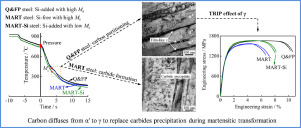当前位置:
X-MOL 学术
›
Scr. Mater.
›
论文详情
Our official English website, www.x-mol.net, welcomes your
feedback! (Note: you will need to create a separate account there.)
Quenching and flash-partitioning enables austenite stabilization during press-hardening processing
Scripta Materialia ( IF 5.3 ) Pub Date : 2020-03-01 , DOI: 10.1016/j.scriptamat.2019.10.047 H.L. Cai , P. Chen , J.K. Oh , Y.R. Cho , D. Wu , H.L. Yi
Scripta Materialia ( IF 5.3 ) Pub Date : 2020-03-01 , DOI: 10.1016/j.scriptamat.2019.10.047 H.L. Cai , P. Chen , J.K. Oh , Y.R. Cho , D. Wu , H.L. Yi

|
Abstract Quenching and flash-partitioning (Q&FP) concept is proposed based upon carbon diffusion associated with the martensitic transformation. For the Si-added steel having an elevated martensite start (Ms) temperature, carbon can diffuse rapidly from martensite laths into their adjacent austenite within only a few seconds during the martensitic transformation, to replace carbides precipitation by auto-tempering in the Si-free steel. Elevating Ms in alloy design based on the Q&FP concept enables the stabilization of retained austenite during press hardening. The transformation-induced plasticity effect of retained austenite films improved the total elongation of press-hardened steel to 10.5% combining with 1660 MPa tensile strength.
中文翻译:

淬火和快速分割可在压制硬化过程中实现奥氏体稳定
摘要 基于与马氏体转变相关的碳扩散,提出了淬火和闪蒸分配 (Q&FP) 概念。对于马氏体起始温度 (Ms) 较高的加硅钢,在马氏体转变过程中,碳可以在短短几秒钟内从马氏体板条迅速扩散到其相邻的奥氏体中,以通过自动回火代替无硅钢中的碳化物析出钢。在基于 Q&FP 概念的合金设计中提升 Ms,可以在压制硬化过程中稳定残余奥氏体。残余奥氏体膜的相变诱导塑性效应将压制硬化钢的总伸长率提高到 10.5%,并结合 1660 MPa 的抗拉强度。
更新日期:2020-03-01
中文翻译:

淬火和快速分割可在压制硬化过程中实现奥氏体稳定
摘要 基于与马氏体转变相关的碳扩散,提出了淬火和闪蒸分配 (Q&FP) 概念。对于马氏体起始温度 (Ms) 较高的加硅钢,在马氏体转变过程中,碳可以在短短几秒钟内从马氏体板条迅速扩散到其相邻的奥氏体中,以通过自动回火代替无硅钢中的碳化物析出钢。在基于 Q&FP 概念的合金设计中提升 Ms,可以在压制硬化过程中稳定残余奥氏体。残余奥氏体膜的相变诱导塑性效应将压制硬化钢的总伸长率提高到 10.5%,并结合 1660 MPa 的抗拉强度。











































 京公网安备 11010802027423号
京公网安备 11010802027423号